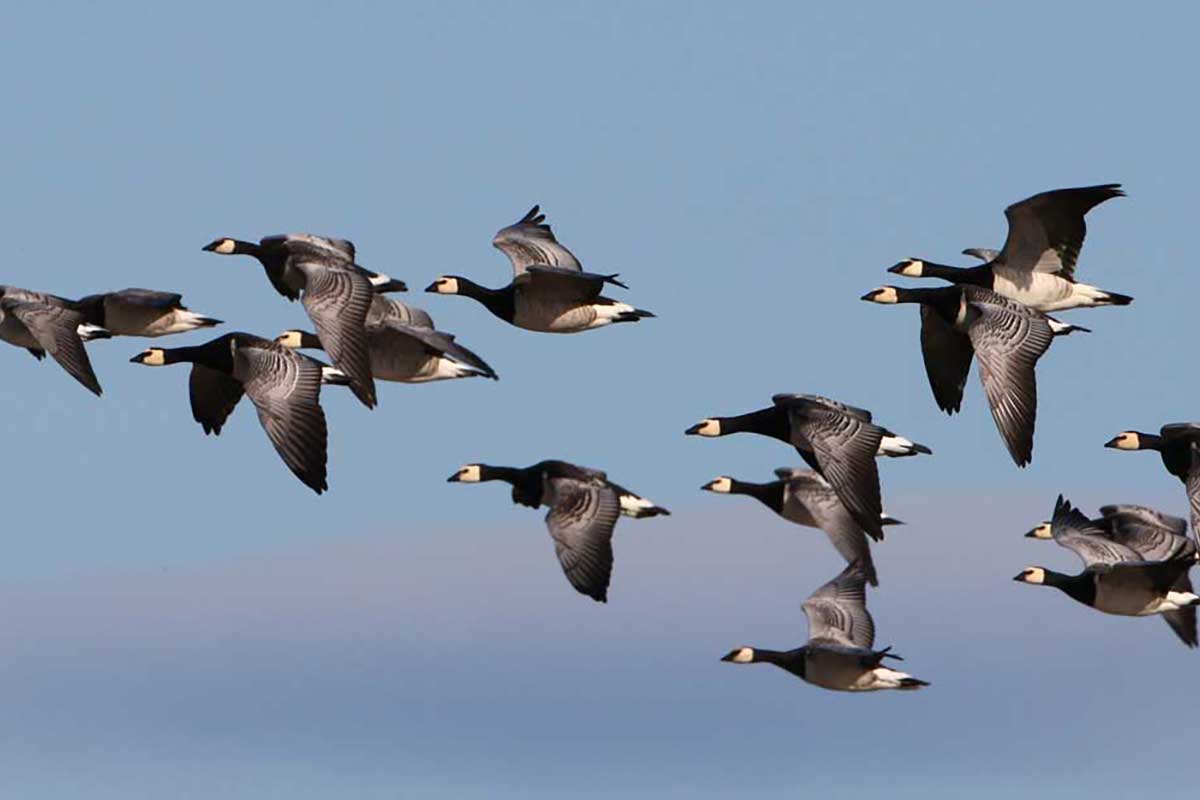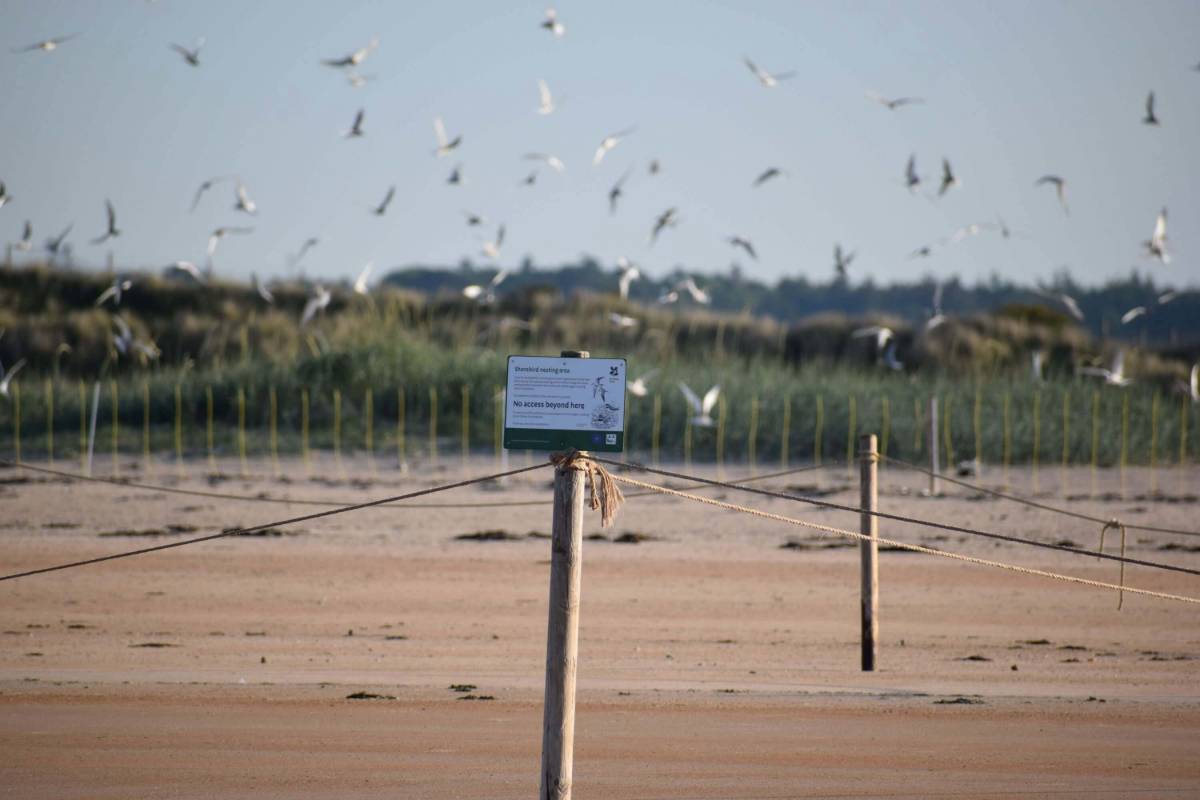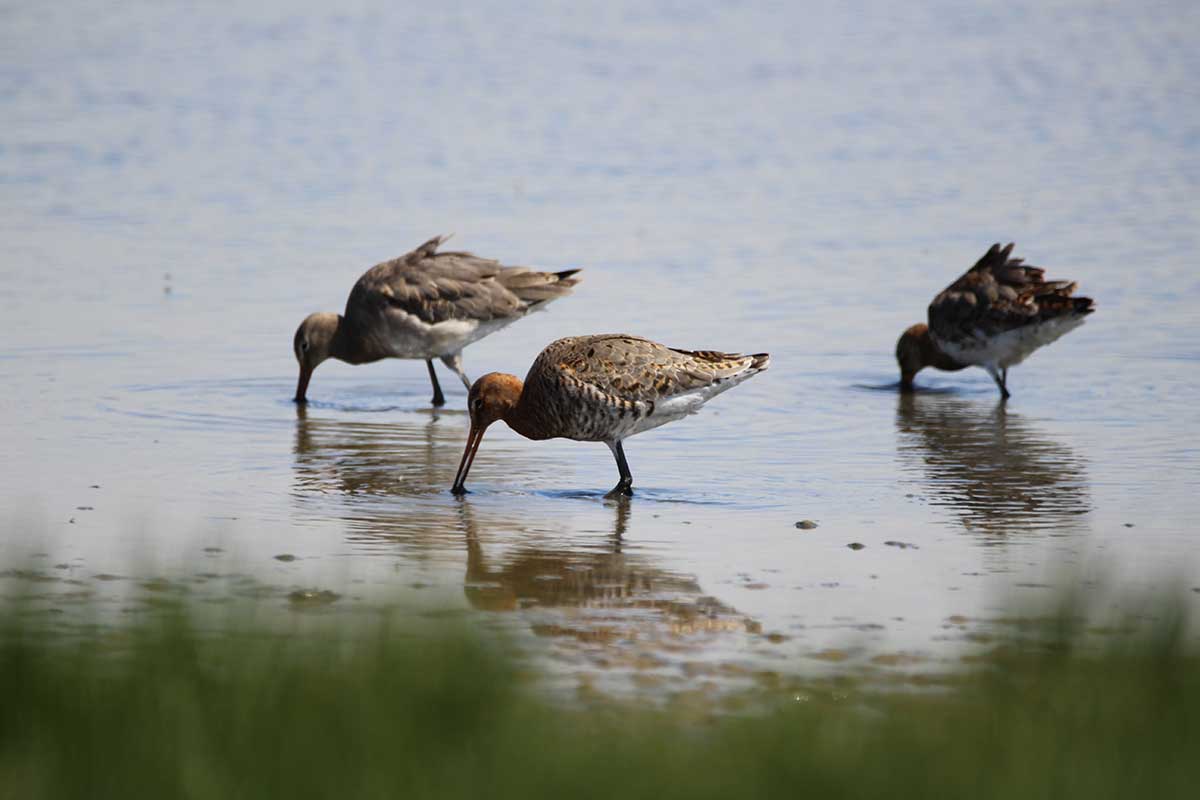
A spotters’ guide to the shorebirds, wildfowl and seals of the Northumberland Coast. Please find out more about the wonderful species in our spotlight below, or get in touch for further information.
Larus marinus
Identifying features
Large gull with powerful, thick yellow bill. Dark black back and wings with pale legs.
Where to spot
Widespread along the coast with large roosts at Lindisfarne National Nature Reserve.
Chroicocephalus ridibundus
Identifying features
Small sized gull with chocolate-brown head in summer plumage, white in winter plumage. Red legs and bill.
Where to spot
Breed on the Farne Island National Nature Reserve, feed along the coastal waters.
Larus fuscus
Identifying features
Dark grey back and wings with yellow legs and yellow bill.
Where to spot
Widespread along the coast with large roosts at Lindisfarne National Nature Reserve.
Larus argentatus
Identifying features
Pale grey backs and wings, pale legs and yellow bill.
Where to spot
Widespread along the coast with large roosts at Lindisfarne National Nature Reserve.
Anser anser
Identifying features
Light grey with a bulky orange bill and legs.
Where to spot
Roosting along the coast and feeding on adjacent farmland.
Anser brachyrhynchus
Identifying features
Grey with pink bill and feet.
Where to spot
Budle Bay viewing platform at Lindisfarne National Nature Reserve, roost on beaches and feed on adjacent farmland.
Branta leucopsis
Identifying features
Distinctive contrasting black head, neck and breast, white face and belly.
Where to spot
Internationally important numbers at Lindisfarne National Nature Reserve, especially Budle Bay viewing platform.
Did you know? Barnacle Geese nest on cliffs in the Arctic. The goslings must leap from the cliffs to find their parents hundreds of metres below—
whilst dodging Arctic Foxes!
Branta bernicla
Identifying features
Small, black head and neck with a white neck stripe.
Where to spot
50% of worlds East-Atlantic population can be found at Lindisfarne National Nature Reserve.
Cygnus cygnus
Identifying features
White swan with yellow bill.
Where to spot
Coastal and adjacent farmland.
Cygnus olor
Identifying features
Large white swan with orange and black bill.
Where to spot
Coastal, breed on small waterbodies.
Anas crecca
Identifying features
Small duck. Males have chestnut-coloured heads with green eye-patches, females are brown. Both show green wing patches in flight.
Where to spot
Close inshore with good views at Budle Bay Viewing Platform at Lindisfarne National Nature Reserve.
Did you know? A group of Teal is known as a ‘spring’ because they take off almost vertically when startled!
Somateria
Identifying features
Large sea duck with striking black and white plumage of male birds, while females are mottled brown.
Where to spot
Most shelter in offshore bays along the coast. Can be seen on their breeding grounds of the Farne Islands National Nature Reserve and Coquet Island in summer.
Mareca penelope
Identifying features
Medium sized duck, round head with small bill, males have chestnut head/neck with a creamy yellow forehead,
pink breast and grey body.
Where to spot
Feeding along the shores, Fenham flats and Budle Bay viewing platform at Lindisfarne National Nature Reserve.
Clangula hyemalis
Identifying features
Small black and white duck. Males have a long tail, females are browner than the males.
Where to spot
Sheltered bays along the coast.
Melanitta nigra
Identifying features
Dark Sea duck, females are lighter with a pale face and males are totally black.
Where to spot
Along the Northumberland Coast with the largest congregation at Lindisfarne National Nature Reserve.
Mergus serrator
Identifying features
Brown head with shaggy crest and long orange/red bill.
Where to spot
Sheltered bays along the coast, with large numbers at Budle Bay viewing platform at Lindisfarne National Nature Reserve.
Spatula clypeata
Identifying features
Large spatulate bill, males have dark green head.
Where to spot
Coastal and water bodies, Budle Bay viewing platform at Lindisfarne National Nature Reserve.
Tadorna
Identifying features
Dark green head and neck with chestnut belly and a red bill.
Where to spot
Along the coast with large numbers at Budle Bay viewing platform at Lindisfarne National Nature Reserve.
Charadrius hiaticula
Identifying features
Black ‘ring’ around the neck and across the eyes, bright orange bill and legs.
Where to spot
Birds gather in greater numbers outside of the breeding season, but a small population breeds on sandy and shingle beaches, with the largest breeding
population at Lindisfarne National Nature Reserve.
Did you know? Ringed Plovers will pretend to have a broken wing to lure predators away from the nest!
Calidris alba
Identifying features
Bright white plumage in winter and rapid feeding action at the shoreline.
Where to spot
Running back and forth at the water’s edge on sandy beaches.
Pluvialis dominica
Identifying features
Medium sized, golden in colour with short black bill.
Where to spot
Coastal grasslands at Craster and Newton Point, intertidal mudflats and farmland. Largest numbers at Lindisfarne National Nature Reserve.
Pluvialis squatarola
Identifying features
Short black bill and dark legs. Silvery and black in summer with black underwings.
Where to spot
Feed on mudflats and roost along the coast especially at Lindisfarne National Nature Reserve.
Arenaria
Identifying features
Mottled brown, chestnut and black with orange legs.
Where to spot
Most areas of rocky shore and beaches using their short thick bill to rummage through seaweed and move pebbles to look for small crustaceans and insects.
Calidris maritima
Identifying features
Orange-yellow legs and bill base.
Where to spot
Feeding on the edge of the rocky shore – they are true rocky shore experts!
Stag Rocks to the north of Bamburgh Beach is a stronghold.
Calidris alpina
Identifying features
Small wading bird with slightly down-curved bill and black belly in the summer.
Where to spot
Intertidal mudflats and sandy beaches, with the largest flocks found at Lindisfarne National Nature Reserve.
Limosa lapponica
Identifying features
Up-curved long bill, long legs. Grey in winter, chestnut in summer.
Where to spot
Internationally important numbers at Lindisfarne National Nature Reserve.
Tringa totanus
Identifying features
Medium long bill, bright orange-red legs and speckled body.
Where to spot
Intertidal sand and mudflats.
Numenius arquata
Identifying features
Long downward curved bill and distinctive, haunting call.
Where to spot
Edges of salt marshes and mudflats.
Haematopus
Identifying features
Black and white plumage with distinctive long orange-red bill and legs.
Where to spot
Most areas of rocky shore and adjacent farmland. Intertidal areas along the coast and adjacent farmland
Sterna hirundo
Identifying features
Black cap and orange-red bill with black tip and long orange-red legs.
Where to spot
Farne Islands National Nature Reserve and Lindisfarne National Nature Reserve.
Sterna paradisaea
Identifying features
Black cap and red bill and legs with long forked tail.
Where to spot
Long Nanny Tern site, Farne Islands National Nature Reserve and Lindisfarne National Nature Reserve. Northumberland is the southern limit of its breeding range, with Beadnell Bay being one of the UK’s largest mainland breeding sites for these seabirds
Sternula albifrons
Identifying features
Smallest of the tern species. Black cap with white patch on their forehead at the base of their bright yellow bill.
Where to spot
Lindisfarne National Nature Reserve and Long Nanny shorebird site.
Sterna dougallii
Identifying features
A dazzling white tern with a pinkish hue to the breast and long tail streamers.
Where to spot
Spend summers breeding on Coquet Island, off the Northumberland Coast. Roost at Lindisfarne National Nature Reserve post-breeding.
Thalasseus sandvicensis
Identifying features
The largest UK tern species, black shaggy cap and long black bill with a yellow tip, has a distinctive Ker-rick call.
Where to spot
Farne Islands National Nature Reserve and the food-rich waters around the Lindisfarne National Nature Reserve.
Halichoerus grypus
Identifying features
Long, flat, dog-like muzzle with parallel nostrils – bulkier than the Harbour Seal.
Where to spot
Sand flats, mud flats and rocky shores of the coast. Lindisfarne National Nature Reserve provides the largest mainland haul-out site in the region and
the Farne Islands National Nature Reserve in the Autumn.
Phoca vitulina
Identifying features
Short muzzle with diagonal nostrils to form a V and more uniform spots than the Grey Seal, slightly smaller.
Where to spot
Often seen at the bridge on the causeway at Lindisfarne National Nature Reserve.



